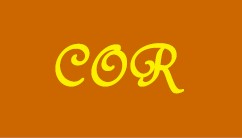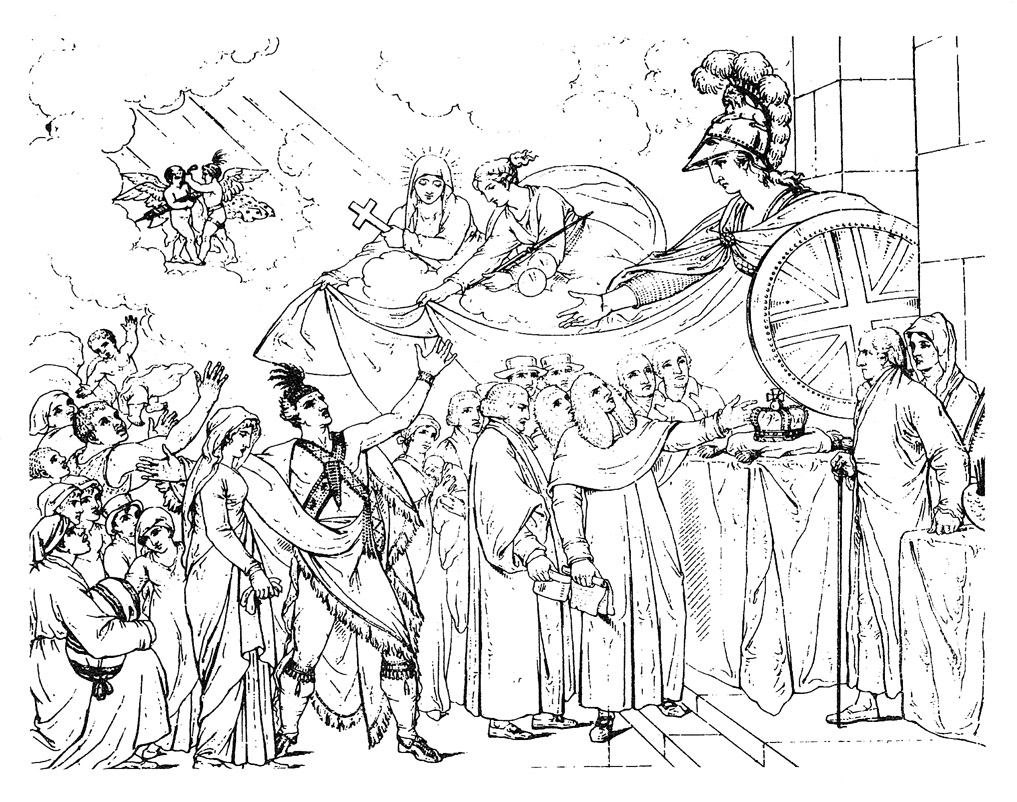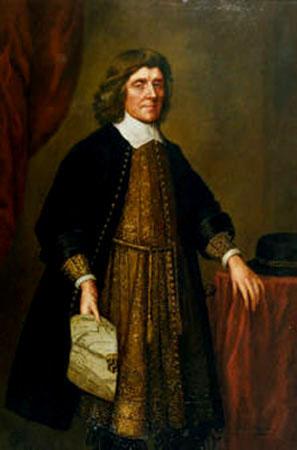|
Clow Rebellion
The Clow Rebellion was a Loyalist insurrection that took place in mid-April 1778, during the American Revolutionary War. It took place on the Delaware side of the Maryland-Delaware border and was led by Cheney Clow (sometimes spelled "China" Clow). The rebellion was suppressed by Maryland and Delaware militia. The insurrection was spurred by a foraging party that arrived in the area in late-February under the command of Henry Lee, who collected supplies for the Continental Army stationed at Valley Forge, Pennsylvania. Discontent over the foraging party led to the formation of an insurrection in March, which grew larger by mid-April, and coalesced under the command of Clow. The insurgents were active in both Maryland and Delaware. Commanding about 200 Loyalists, Clow constructed a fort on his own property, northwest of Dover, near what is today Kenton, Delaware. General William Smallwood William Smallwood (1732February 14, 1792) was an American planter, soldier and politicia ... [...More Info...] [...Related Items...] OR: [Wikipedia] [Google] [Baidu] |
American Revolutionary War
The American Revolutionary War (April 19, 1775 – September 3, 1783), also known as the Revolutionary War or American War of Independence, was a major war of the American Revolution. Widely considered as the war that secured the independence of the United States, fighting began on April 19, 1775, followed by the Lee Resolution on July 2, 1776, and the Declaration of Independence on July 4, 1776. The American Patriots were supported by the Kingdom of France and, to a lesser extent, the Dutch Republic and the Spanish Empire, in a conflict taking place in North America, the Caribbean, and the Atlantic Ocean. Established by royal charter in the 17th and 18th centuries, the American colonies were largely autonomous in domestic affairs and commercially prosperous, trading with Britain and its Caribbean colonies, as well as other European powers via their Caribbean entrepôts. After British victory over the French in the Seven Years' War in 1763, tensions between the motherla ... [...More Info...] [...Related Items...] OR: [Wikipedia] [Google] [Baidu] |
Loyalist (American Revolution)
Loyalists were colonists in the Thirteen Colonies who remained loyal to the British Crown during the American Revolutionary War, often referred to as Tories, Royalists or King's Men at the time. They were opposed by the Patriots, who supported the revolution, and called them "persons inimical to the liberties of America." Prominent Loyalists repeatedly assured the British government that many thousands of them would spring to arms and fight for the crown. The British government acted in expectation of that, especially in the southern campaigns in 1780–81. Britain was able to effectively protect the people only in areas where they had military control, and in return, the number of military Loyalists was significantly lower than what had been expected. Due to the conflicting political views, loyalists were often under suspicion of those in the British military, who did not know whom they could fully trust in such a conflicted situation; they were often looked down upon. Pat ... [...More Info...] [...Related Items...] OR: [Wikipedia] [Google] [Baidu] |
Kenton, Delaware
Kenton is a town in Kent County, Delaware, United States. It is part of the Dover, Delaware Metropolitan Statistical Area. The population was 261 at the 2010 census. History The Village of Kenton is a crossroads community located at the intersection of Route 42 and Route 300 in Kenton Hundred, Delaware. The village dates from the last decade of the 18th century, but did not achieve its peak until the last half of the 19th century when the Delaware and Maryland Railroad line was put through from Clayton to Maryland. and Kenton was first laid out in 1796 by Philip Lewis who had begun to acquire property in the area five years before in 1791. The community was first known as Georgetown, then as Lewis Crossroads and finally, in 1806, by the name of Kenton. The Kenton Historic District was listed on the National Register of Historic Places in 1983. Other sites at or near Kenton on the National Register of Historic Places are the: George Arnold House, Aspendale, Thomas Attix Hou ... [...More Info...] [...Related Items...] OR: [Wikipedia] [Google] [Baidu] |
Delaware
Delaware ( ) is a state in the Mid-Atlantic region of the United States, bordering Maryland to its south and west; Pennsylvania to its north; and New Jersey and the Atlantic Ocean to its east. The state takes its name from the adjacent Delaware Bay, in turn named after Thomas West, 3rd Baron De La Warr, an English nobleman and Virginia's first colonial governor. Delaware occupies the northeastern portion of the Delmarva Peninsula and some islands and territory within the Delaware River. It is the second-smallest and sixth-least populous state, but also the sixth-most densely populated. Delaware's largest city is Wilmington, while the state capital is Dover, the second-largest city in the state. The state is divided into three counties, having the lowest number of counties of any state; from north to south, they are New Castle County, Kent County, and Sussex County. While the southern two counties have historically been predominantly agricultural, New Castle ... [...More Info...] [...Related Items...] OR: [Wikipedia] [Google] [Baidu] |
Cheney Clow
Cheney Clow (1734–1788) was a loyalist from Delaware Colony during the American Revolution who staged a rebellion against the colonial government that was advocating separation from Great Britain. Early life Cheney Clow was born in 1734 in Delaware Colony, the third of nine children of Nathaniel Clow and his wife Susannah. They lived in Queen Anne's County, Province of Maryland, owned their own farm, of unknown acres but was said to have been considerable. Land recorded in 1744, was named "Clow's Hope." In 1747 another was recorded and it was called "Boon's Hope". Boon's Hope cost Nathaniel and Susannah 2,100 pounds of tobacco, which was a common practice in the early colonies, paying for items with tobacco off your own land. Nathaniel Clow died in 1748, his estate papers and will are filed in the courthouse in Annapolis. He wanted his estate divided equally among his wife and children. The children were John (born 1732), Mary (born 1733), Cheney (born 1734), Susannah (born 17 ... [...More Info...] [...Related Items...] OR: [Wikipedia] [Google] [Baidu] |
Loyalist
Loyalism, in the United Kingdom, its overseas territories and its former colonies, refers to the allegiance to the British crown or the United Kingdom. In North America, the most common usage of the term refers to loyalty to the British Crown, notably with the loyalists opponents of the American Revolution, and United Empire Loyalists who moved to other colonies in British North America after the revolution. Historical loyalism 18th century North America In North America, the term ''loyalist'' characterised colonists who rejected the American Revolution in favour of remaining loyal to the king. American loyalists included royal officials, Anglican clergymen, wealthy merchants with ties to London, demobilised British soldiers, and recent arrivals (especially from Scotland), as well as many ordinary colonists who were conservative by nature and/or felt that the protection of Britain was needed. Colonists with loyalist sympathies accounted for an estimated 15 per cent to ... [...More Info...] [...Related Items...] OR: [Wikipedia] [Google] [Baidu] |
Maryland
Maryland ( ) is a U.S. state, state in the Mid-Atlantic (United States), Mid-Atlantic region of the United States. It shares borders with Virginia, West Virginia, and the District of Columbia to its south and west; Pennsylvania to its north; and Delaware and the Atlantic Ocean to its east. Baltimore is the largest city in the state, and the capital is Annapolis, Maryland, Annapolis. Among its occasional nicknames are ''Maryland 400, Old Line State'', the ''Free State'', and the ''Chesapeake Bay State''. It is named after Henrietta Maria, the French-born queen of England, Scotland, and Ireland, who was known then in England as Mary. Before its coastline was explored by Europeans in the 16th century, Maryland was inhabited by several groups of Native Americans – mostly by Algonquian peoples and, to a lesser degree, Iroquoian peoples, Iroquoian and Siouan languages, Siouan. As one of the original Thirteen Colonies of England, Maryland was founded by George Calvert, 1st Baron Ba ... [...More Info...] [...Related Items...] OR: [Wikipedia] [Google] [Baidu] |
Henry Lee III
Henry Lee III (January 29, 1756 – March 25, 1818) was an early American Patriot and U.S. politician who served as the ninth Governor of Virginia and as the Virginia Representative to the United States Congress. Lee's service during the American Revolution as a cavalry officer in the Continental Army earned him the nickname by which he is best known, "Light-Horse Harry".In the military parlance of the time, the term "Light-horse" had a hyphen between the two words "light" and "horse". See the title page of ''The Discipline of the Light-Horse. By Captain Hinde, of the Royal Regiment of Foresters, (Light-Dragoons.)'' published in London in 1778, a cavalry tactics classic which was used as a manual. He was the father of Robert E. Lee, who led Confederate armies against the U.S. in the American Civil War. Life and career Early life and family Lee was born on Leesylvania Plantation in Prince William County in the Colony of Virginia. He was the son of Col. Henry Lee II (173 ... [...More Info...] [...Related Items...] OR: [Wikipedia] [Google] [Baidu] |
Continental Army
The Continental Army was the army of the United Colonies (the Thirteen Colonies) in the Revolutionary-era United States. It was formed by the Second Continental Congress after the outbreak of the American Revolutionary War, and was established by a resolution of Congress on June 14, 1775. The Continental Army was created to coordinate military efforts of the Colonies in their war for independence against the British, who sought to keep their American lands under control. General George Washington was the commander-in-chief of the army throughout the war. The Continental Army was supplemented by local militias and volunteer troops that were either loyal to individual states or otherwise independent. Most of the Continental Army was disbanded in 1783 after the Treaty of Paris formally ended the fighting. The 1st and 2nd Regiments of the Army went on to form what was to become the Legion of the United States in 1792. This became the foundation of what is now the United St ... [...More Info...] [...Related Items...] OR: [Wikipedia] [Google] [Baidu] |
Valley Forge
Valley Forge functioned as the third of eight winter encampments for the Continental Army's main body, commanded by General officer, General George Washington, during the American Revolutionary War. In September 1777, Congress fled Philadelphia to escape the British capture of the city. After failing to retake Philadelphia, Washington led his 12,000-man army into winter quarters at Valley Forge, located approximately 18 miles (29 km) northwest of Philadelphia. They remained there for six months, from December 19, 1777 to June 19, 1778. At Valley Forge, the Continentals struggled to manage a disastrous supply crisis while retraining and reorganizing their units. About 1,700 to 2,000 soldiers died from disease, possibly exacerbated by malnutrition. Today, Valley Forge National Historical Park protects and preserves over 3,500 acres of the original encampment site. Pre-encampment In 1777, Valley Forge consisted of a small Proto-industrialization, proto-industrial community ... [...More Info...] [...Related Items...] OR: [Wikipedia] [Google] [Baidu] |
Pennsylvania
Pennsylvania (; (Pennsylvania Dutch: )), officially the Commonwealth of Pennsylvania, is a state spanning the Mid-Atlantic, Northeastern, Appalachian, and Great Lakes regions of the United States. It borders Delaware to its southeast, Maryland to its south, West Virginia to its southwest, Ohio to its west, Lake Erie and the Canadian province of Ontario to its northwest, New York to its north, and the Delaware River and New Jersey to its east. Pennsylvania is the List of U.S. states and territories by population, fifth-most populous state in the nation with over 13 million residents 2020 United States census, as of 2020. It is the List of U.S. states and territories by area, 33rd-largest state by area and ranks List of states and territories of the United States by population density, ninth among all states in population density. The southeastern Delaware Valley metropolitan area comprises and surrounds Philadelphia, the state's List of cities in Pennsylvania, largest ... [...More Info...] [...Related Items...] OR: [Wikipedia] [Google] [Baidu] |






